|
|
 |
 |
 |
 |
 |
 |
 |
 |
 |
 |
 |
 |
|
|
|
|
|
1992: When we explored the Eastman property, we noticed small holes dug in the soil going uphill from the 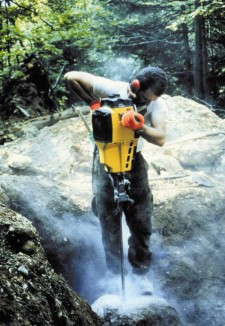 main pit and followed them through the overgrowth. Occasionally we came
upon a larger pit and finally at the top we found a major excavation about 12 feet in diameter. Restricted as we were by the bureaucracies of the
National Forest Service, we chose this place to begin our exploration as it was the only logical area in which to conduct a by-hand operation. main pit and followed them through the overgrowth. Occasionally we came
upon a larger pit and finally at the top we found a major excavation about 12 feet in diameter. Restricted as we were by the bureaucracies of the
National Forest Service, we chose this place to begin our exploration as it was the only logical area in which to conduct a by-hand operation.  With shovels, wheelbarrows, a Cobra rock drill and minor use of explosive we widened and deepened the hole by a
decent percentage over the following months and were rewarded with several pockets of smoky quartz packed in hardened gray clay. The most interesting specimens contained liquid inclusions with movable
bubbles and slight hints of purple. The weather shut us down in October so we spent the winter looking for a small, affordable excavator capable of
negotiating a path through the woods that did not cross the White Mountains National Forest. Finally, with the help of Uncle Henry, we located and purchased a 5500 lb. Bobcat
and with high hopes, eagerly awaited the arrival of spring. With shovels, wheelbarrows, a Cobra rock drill and minor use of explosive we widened and deepened the hole by a
decent percentage over the following months and were rewarded with several pockets of smoky quartz packed in hardened gray clay. The most interesting specimens contained liquid inclusions with movable
bubbles and slight hints of purple. The weather shut us down in October so we spent the winter looking for a small, affordable excavator capable of
negotiating a path through the woods that did not cross the White Mountains National Forest. Finally, with the help of Uncle Henry, we located and purchased a 5500 lb. Bobcat
and with high hopes, eagerly awaited the arrival of spring. |
|
|
|
1993:
As soon as the woods were clear of snow and the ground dried out a little (mid May); we moved the excavator to the bottom of the mountain and began the two-day harrowing ordeal of getting
the machine to the mine. We were forced to use an abandoned logging road that went more or less straight up the hill. At some points in the journey, we were forced to use the arm and bucket of the excavator to push
ourselves uphill. We had to put a track back on three times and almost rolled the machine twice but after 8 hours, we completed the three-quarter mile journey. Anticipating smoky quartz pockets by the bucketful, we
immediately began to dig and in half an hour we had matched the entire amount of digging done by hand the summer before.
|
|
|
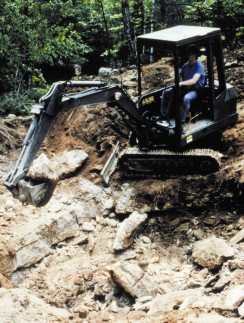 The next weekend we returned to dig some more and blast. After the
explosion and subsequent removal of rubble, we found nothing. The next day we continued to find nothing. Weekend after weekend we found nothing and were getting discouraged toward the end of June. On the
last weekend in June, we made a pact. If we didn't find anything by the end of the weekend we would move downhill to the Eastman Quarry and start digging for the fabled buried amethyst pockets at the bottom of the
rubble filled pit. Just Jay and myself were at the mine that weekend and between the two of us we came up with our do-or-die plan. We would try to sink the bottom of the pit several feet and look for promising
mineralization. To do this we would have to do a plug blast, a tricky and slightly dangerous procedure consisting of drilling holes at an angle
around a central point. Theoretically, an explosive charge in each one of the holes at once would free a large chunk of ledge from the bottom of
the pit. Even more theoretically, one could direct the trajectory of the chunk by altering the amount of explosive in each hole. Realistically, we would be a long way away and hiding behind very large trees. The next weekend we returned to dig some more and blast. After the
explosion and subsequent removal of rubble, we found nothing. The next day we continued to find nothing. Weekend after weekend we found nothing and were getting discouraged toward the end of June. On the
last weekend in June, we made a pact. If we didn't find anything by the end of the weekend we would move downhill to the Eastman Quarry and start digging for the fabled buried amethyst pockets at the bottom of the
rubble filled pit. Just Jay and myself were at the mine that weekend and between the two of us we came up with our do-or-die plan. We would try to sink the bottom of the pit several feet and look for promising
mineralization. To do this we would have to do a plug blast, a tricky and slightly dangerous procedure consisting of drilling holes at an angle
around a central point. Theoretically, an explosive charge in each one of the holes at once would free a large chunk of ledge from the bottom of
the pit. Even more theoretically, one could direct the trajectory of the chunk by altering the amount of explosive in each hole. Realistically, we would be a long way away and hiding behind very large trees.
|
|
|
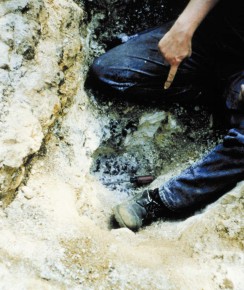 We began to drill in mid afternoon on Saturday. At about the three foot
point, the drill suddenly and instantly sank out of site. Perplexed, but not particularly excited, we pulled it out and moved it over a few feet. We
were assuming at this point that we had hit a crack or the edge of a slab. We drill another hole and at the same level, the drill sank out of site
again. The first shivers of excitement coursed their way through us but we tempered them with the theory of interconnected small smoky pockets. We pulled the drill out again and moved it over a few more feet. We began to drill in mid afternoon on Saturday. At about the three foot
point, the drill suddenly and instantly sank out of site. Perplexed, but not particularly excited, we pulled it out and moved it over a few feet. We
were assuming at this point that we had hit a crack or the edge of a slab. We drill another hole and at the same level, the drill sank out of site
again. The first shivers of excitement coursed their way through us but we tempered them with the theory of interconnected small smoky pockets. We pulled the drill out again and moved it over a few more feet.
Again it sank out of sight and we looked at each other in unspoken hope.
Finally, after moving the drill back and not drilling as deep, we were able
to get four more or less solid holes in a vaguely circular pattern. It was late at this point and so we elected to wait until the next day to blow it in case it actually turned out to be something significant.
|
|
|
Sunday morning we arrived, sweating and panting as usual from our 1.5 mile trek up the mountain carrying an 80 lb. rock drill and the associated supplies. We loaded the holes, found an oak tree that
fit our distance/diameter requirements and set off the charge. We anxiously checked the hole as soon as the nitro fumes were down to a safe level and were greeted with the sight of a rubble filled hole in the
ground. Half an hour of shoveling by the two of us resulted in a hole about three feet in diameter and two feet deep. Suddenly, Jay noticed a few pieces of amethyst on the end of his shovel. It was good amethyst,
not the usual nasty pale crumbly stuff we were used to finding. Still, we refused to allow both of us were bringing up ourselves to believe we had found anything more than a small vein of purple quartz. We continued
digging and now significant amounts of amethyst with every shovelful. We started putting it in a bucket along with the sugar-like powdered white rock that was coming up also. Finally we reached the bottom of the
hole. It was about a foot in diameter and composed of light to medium amethyst along one side and the white powdery rock covering the rest.
|
|
|
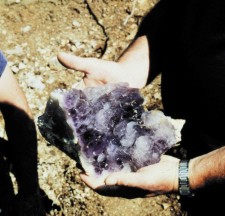 We fell upon the amethyst with a screwdriver and rock pick. Using these
tools, we pried out chunk after chunk and began rapidly filling the first 5 gallon pail. I couldn't believe that we had actually made a major discovery,
instead, I theorized that we had merely uncovered a section of pegmatite core in which the quartz had developed as amethyst. There would therefore
be a limited amount of gem and nothing to get overly excited about. Then we found a chunk that would cut about a 20 carat deep purple stone. In about 5
hours, we filled 4 five gallon buckets with amethyst chunks and had reached our carrying capacity. We filled in the hole which was now about two feet deeper and lined on the bottom with a solid, deep purple,
one-foot-in-diameter mass of amethyst. Packing up all our equipment, we lifted our 160 lbs. of amethyst (4 five gallon buckets) and took turns packing
the 80 lbs. drill on our back as we trudged down the hill with more amethyst that either of us had ever seen. We fell upon the amethyst with a screwdriver and rock pick. Using these
tools, we pried out chunk after chunk and began rapidly filling the first 5 gallon pail. I couldn't believe that we had actually made a major discovery,
instead, I theorized that we had merely uncovered a section of pegmatite core in which the quartz had developed as amethyst. There would therefore
be a limited amount of gem and nothing to get overly excited about. Then we found a chunk that would cut about a 20 carat deep purple stone. In about 5
hours, we filled 4 five gallon buckets with amethyst chunks and had reached our carrying capacity. We filled in the hole which was now about two feet deeper and lined on the bottom with a solid, deep purple,
one-foot-in-diameter mass of amethyst. Packing up all our equipment, we lifted our 160 lbs. of amethyst (4 five gallon buckets) and took turns packing
the 80 lbs. drill on our back as we trudged down the hill with more amethyst that either of us had ever seen.
|
|
|
|
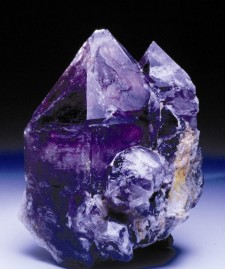 As fate would have it, Gary had chosen that Sunday to pop in for a visit. He
was walking up the old mine road as we were stumbling down the logging road. We saw his truck in the parking area and honked a few times to try to
summon him. He didn’t come down so we left after leaving a note on his windshield asking him to stop by my house on his way home. "I had
something interesting to show him." Jay had to get home so he left before Gary could get there. When he did arrive and saw what we had found, he
was understandably ecstatic and couldn’t wait to get back there to see for himself. We agreed we would go on Wednesday and dig the hole back out so he could witness it. As fate would have it, Gary had chosen that Sunday to pop in for a visit. He
was walking up the old mine road as we were stumbling down the logging road. We saw his truck in the parking area and honked a few times to try to
summon him. He didn’t come down so we left after leaving a note on his windshield asking him to stop by my house on his way home. "I had
something interesting to show him." Jay had to get home so he left before Gary could get there. When he did arrive and saw what we had found, he
was understandably ecstatic and couldn’t wait to get back there to see for himself. We agreed we would go on Wednesday and dig the hole back out so he could witness it.
Wednesday arrived, we hiked back up the mountain as planned and dug the hole out again. We were both spellbound, me again, he for the first time. In
the dwindling light, we pried out another couple of buckets worth of amethyst chunks. The last chunk we took out that evening came hard as it was
attached to the side of the hole. Finally, I pried it loose and turned it over. The entire back was crystallized and gemmy. There was now no doubt at all that we were in a pocket and
judging from the amount of material removed so far (with no end in sight) it was indeed a large one.
|
|
|
|
Back to Top
|
|
|
|
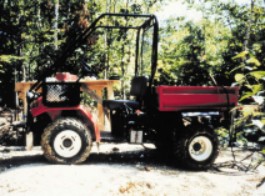 Jay meanwhile had purchased a Kawasaki Mule all terrain vehicle.
This is a utility ATV which almost seems specifically designed for small mining operations. It has a bed like a miniature dump truck and even dumps. We drove it to the mine the following Saturday
morning. Gary was doing a craft show and was unable to attend the opening of the pocket. With about 4 or five trusted friends, we dug out the hole again, put in a tiny blast to widen the opening and began
to mine amethyst like no one had ever experienced. Jay meanwhile had purchased a Kawasaki Mule all terrain vehicle.
This is a utility ATV which almost seems specifically designed for small mining operations. It has a bed like a miniature dump truck and even dumps. We drove it to the mine the following Saturday
morning. Gary was doing a craft show and was unable to attend the opening of the pocket. With about 4 or five trusted friends, we dug out the hole again, put in a tiny blast to widen the opening and began
to mine amethyst like no one had ever experienced.
The day was a barely remembered haze of sensory overload to me. We pulled out museum specimen after museum specimen, bucket
after bucket. The gem rough was absolutely mind boggling. At one point, who ever was in the hole handed me
a huge crystal which weighed literal pounds. This crystal later became known as "The Grape of Maine",
tongue-in-cheek tribute to the famous "Rose of Maine" Morganite specimen uncovered by the Holden brothers at the Bennet quarry some years earlier. We actually filed the back of the ATV twice and had to
make two trips down the mountain. Later in my basement, the specimens 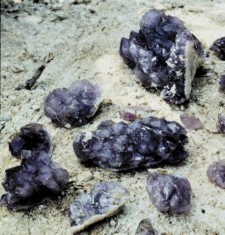 covered my floor and limited bench
space. Sunday was no different, we pulled out hundreds and hundreds of amethyst- crystals, specimens, chunks, gem rough, it was truly incomprehensible. I had to work the Monday and so Gary ran the show. covered my floor and limited bench
space. Sunday was no different, we pulled out hundreds and hundreds of amethyst- crystals, specimens, chunks, gem rough, it was truly incomprehensible. I had to work the Monday and so Gary ran the show.
The production was the same, countless pounds of amethyst in all categories. Tuesday became almost boring as the monotony of removing
museum-grade amethyst dragged on. By the end of the week, the pocket was mostly cleaned out and Jay, Gary and I held a conference inside it to decide how to handle our unexpected jackpot. We decided to hold a press
conference for publicity's sake (and to claim our 15 minutes of fame). By now the papers had gotten wind of it somehow anyway so it was really
inevitable and this way we could control the level of exaggeration about the find.
|
|
|
|
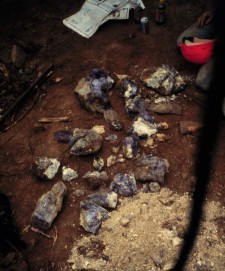 We held the press conference in Perham's and were very well received by
everyone involved and attending. After the initial interview we brought the entire mob to the mine site and shuttled them up the mountain in the ATV so they could see and film the pocket firsthand. We went home and
watched ourselves on all major nightly news that evening. Later a college friend of mine in Phoenix saw us on CNN and we even made the tabloid
"The Sun". This last implication was disturbing as we were in the same issue as "Mummy awakens after 1000 years" and the article regarding us
was mostly factual. After the commotion died down a little we resumed exploration of the pocket. In the upper end of the 6 foot by 4 foot hole, we
discovered a tube which was lined with a chunk of dark gemmy amethyst estimated to weigh about 200 lbs. In the bottom of the pocket, another tube was discovered which led to another pocket as big and productive as
the first one. We held the press conference in Perham's and were very well received by
everyone involved and attending. After the initial interview we brought the entire mob to the mine site and shuttled them up the mountain in the ATV so they could see and film the pocket firsthand. We went home and
watched ourselves on all major nightly news that evening. Later a college friend of mine in Phoenix saw us on CNN and we even made the tabloid
"The Sun". This last implication was disturbing as we were in the same issue as "Mummy awakens after 1000 years" and the article regarding us
was mostly factual. After the commotion died down a little we resumed exploration of the pocket. In the upper end of the 6 foot by 4 foot hole, we
discovered a tube which was lined with a chunk of dark gemmy amethyst estimated to weigh about 200 lbs. In the bottom of the pocket, another tube was discovered which led to another pocket as big and productive as
the first one.
|
|
|
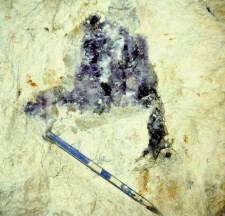 And the excitement (sans media coverage) began again. As the Summer
progressed, we explored this pocket and when we had dug it out completely, we uncovered another tube leading out of the back of it. This tube was about 3 feet long and completely packed with gem rough. It led
unbelievably into another pocket which was bigger than either of the first two. To get the pockets straight, we named them. The first was called the
The 4th of July pocket as we found it over that weekend. The little tube at the upper end was called "1A" by Gary. Pocket number 2 was called "The
Well of Grapes" in joking reference to "The Well of Souls", the resting place of the Ark of the Covenant in "Raiders of the Lost Ark". The third
pocket was simply called "pocket 3" The entire complex was more or less considered to be "the 4th of July pocket" when labeling specimens.
Finally, cold weather shut us down again and we closed the mine up for the season. And the excitement (sans media coverage) began again. As the Summer
progressed, we explored this pocket and when we had dug it out completely, we uncovered another tube leading out of the back of it. This tube was about 3 feet long and completely packed with gem rough. It led
unbelievably into another pocket which was bigger than either of the first two. To get the pockets straight, we named them. The first was called the
The 4th of July pocket as we found it over that weekend. The little tube at the upper end was called "1A" by Gary. Pocket number 2 was called "The
Well of Grapes" in joking reference to "The Well of Souls", the resting place of the Ark of the Covenant in "Raiders of the Lost Ark". The third
pocket was simply called "pocket 3" The entire complex was more or less considered to be "the 4th of July pocket" when labeling specimens.
Finally, cold weather shut us down again and we closed the mine up for the season.
|
|
|
|
 1994: This year, we decided to scrape the overburden off the entire site.
To do this, we needed the use of a much larger excavator and so hired a local contractor to do it. He brought an immense machine to the site along the same road we had used earlier and cleared off a vast expanse
of ledge. The second day of operation, I witnessed a vaguely purple dust cloud as he scraped along a section of ledge. Motioning for him to hold up a sec, I investigated and found that he had scraped into a gigantic
surface 1994: This year, we decided to scrape the overburden off the entire site.
To do this, we needed the use of a much larger excavator and so hired a local contractor to do it. He brought an immense machine to the site along the same road we had used earlier and cleared off a vast expanse
of ledge. The second day of operation, I witnessed a vaguely purple dust cloud as he scraped along a section of ledge. Motioning for him to hold up a sec, I investigated and found that he had scraped into a gigantic
surface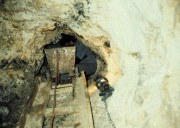 pocket. For the next two days, we pried glacially packed
amethyst out of hole about 3 feet by 4 feet in diameter. Ironically, this pocket was located mere inches from where we had been digging by hand two years earlier. Anyone with a shovel could have dug to it in a
matter of minutes at any point in human history. Though the material was crushed beyond the capacity for specimen purposes, it yielded many pounds of gem rough.
After such a wonderful start, the rest of the year was surprisingly unproductive. pocket. For the next two days, we pried glacially packed
amethyst out of hole about 3 feet by 4 feet in diameter. Ironically, this pocket was located mere inches from where we had been digging by hand two years earlier. Anyone with a shovel could have dug to it in a
matter of minutes at any point in human history. Though the material was crushed beyond the capacity for specimen purposes, it yielded many pounds of gem rough.
After such a wonderful start, the rest of the year was surprisingly unproductive.
|
|
|
Back to Top
|
|
|
|
 1995: This year, the game plan was to begin a open pit mine, gradually
working our way down to the 4th of July complex level estimated to be about 10 to 15 feet underground. After several weeks of slow, foot by foot descent, we finally broke into a small pocket about 8 feet
underground. This pocket contained specimen grade smoky and amethyst quartz and was fairly encouraging. A few feet further, we found another pocket and soon we found our self hitting a pocket of amethyst
or smoky/amethyst every few feet of lateral progress through the pocket zone. By the end of the summer, we had developed a fairly sizable pit and had uncovered numerous nice pockets, the largest of which was almost
big enough to crawl into. Specimen production for 1995 was good, gem production was poor, only about 15 pounds of high graded material. We surmised that all of these pockets were related to the original 4th of July
complex and in fact on our last day of mining, broke into the complex which was by now completely filled with water and completely flooded the entire pit. 1995: This year, the game plan was to begin a open pit mine, gradually
working our way down to the 4th of July complex level estimated to be about 10 to 15 feet underground. After several weeks of slow, foot by foot descent, we finally broke into a small pocket about 8 feet
underground. This pocket contained specimen grade smoky and amethyst quartz and was fairly encouraging. A few feet further, we found another pocket and soon we found our self hitting a pocket of amethyst
or smoky/amethyst every few feet of lateral progress through the pocket zone. By the end of the summer, we had developed a fairly sizable pit and had uncovered numerous nice pockets, the largest of which was almost
big enough to crawl into. Specimen production for 1995 was good, gem production was poor, only about 15 pounds of high graded material. We surmised that all of these pockets were related to the original 4th of July
complex and in fact on our last day of mining, broke into the complex which was by now completely filled with water and completely flooded the entire pit.
|
|
|
1996: This year was a frustrating, mostly fruitless consumption of diesel and explosives. There were no more pockets to be found as we mined through the 4th of July complex. We had tons of overburden covering the complex and it all had to be removed. The only respite from this arduous and unending task was Gary's unexpected luck in the Eastman Quarry. As Jay and I worked in the Intergalactic pit, Gary, bored, decided to put in a blast in the upper end of the Eastman Quarry just for the hell of it. A few minutes after he started to drill, the noise from the jackhammer stopped and shortly Gary came up to where we were working. He told us he had drilled into a pocket. Naturally we doubted this wild claim and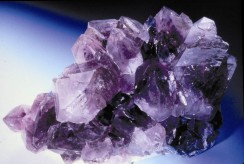 followed him back down to the quarry so
that we could laugh at him. We freed the drill bit and drilled again about two feet away from the first hole. About 1 foot down, the drill sank out of
sight. It did the same thing 2 feet away from that hole. Jay and I looked at each other in sudden deja-vu. We got a couple of solid holes finally and blew it. Sure enough, Gary had found a pocket. followed him back down to the quarry so
that we could laugh at him. We freed the drill bit and drilled again about two feet away from the first hole. About 1 foot down, the drill sank out of
sight. It did the same thing 2 feet away from that hole. Jay and I looked at each other in sudden deja-vu. We got a couple of solid holes finally and blew it. Sure enough, Gary had found a pocket. 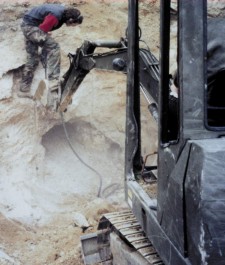 It took us two days to get the majority of the pocket contents out. The contents included
hundreds of pounds of beautiful dark amethyst as well as odd milky-over-smoky quartz specimens. The remarkable thing about this pocket was that it was literally exposed to the surface. Under two inches of
dirt, there was a 2 foot diameter hole filled with snow-white kaolin which led to a 5 foot diameter pocket filled with 700 lbs. of Amethyst. Anyone with a
plastic spoon could have dug to it in about 3 minutes. Continued exploration of this pocket area resulted in the discovery of a cantalope-sized pocket in
solid quartz filled with what appeared to be ugly, frosted, unremarkable pencil diameter quartz crystals. By chance, one of us noticed the end of a
broken crystal and was surprised to see a gemmy yellow/brown interior. Gems cut from these crystals are almost Citrine in color, a pretty,
honey-yellow color. Continued work at the Intergalactic pit resulted in nothing at all. It took us two days to get the majority of the pocket contents out. The contents included
hundreds of pounds of beautiful dark amethyst as well as odd milky-over-smoky quartz specimens. The remarkable thing about this pocket was that it was literally exposed to the surface. Under two inches of
dirt, there was a 2 foot diameter hole filled with snow-white kaolin which led to a 5 foot diameter pocket filled with 700 lbs. of Amethyst. Anyone with a
plastic spoon could have dug to it in about 3 minutes. Continued exploration of this pocket area resulted in the discovery of a cantalope-sized pocket in
solid quartz filled with what appeared to be ugly, frosted, unremarkable pencil diameter quartz crystals. By chance, one of us noticed the end of a
broken crystal and was surprised to see a gemmy yellow/brown interior. Gems cut from these crystals are almost Citrine in color, a pretty,
honey-yellow color. Continued work at the Intergalactic pit resulted in nothing at all. |
|
|
Back to Top
|
|
|
|
1997: This year we worked all season and found nothing at all. We finished the removal of the remaining sections of the 4th of July complex. The only thing of interest was the discovery of a basalt dike which borders the southeastern side of the Eastman Pegmatite. This apparently is the border of the pocket zone on that side of the pegmatite as the pocket complex seemed to be a consistent three or four feet from it. It is possible there is another pocket area on the other side but it is over 6 feet thick and will be hell to blast and remove. The last blast revealed a nice colored dike of amethyst about 3 feet past where area "1A" in the original 4th of July pocket had been. A hopeful sign?
|
|
|
1998: Despite the encouraging signs from the season before, 1998 was a total bust. we found nothing at all. All season we concentrated on expanding the Intergalactic Pit uphill, assuming that we would find additional pockets in line with the fourth of July complex. Sadly this was not to be the case. at the end of the season, we had gone about 15 feet further uphill and were now dealing with 20 feet of overburden. We had not found one single amethyst pocket in all this rock and so we changed game plans.
|
|
|
1999: In the early spring of 1999, the three of us had a meeting to plan the next couple years of mining. We decided that it was pointless to continue in the direction we had been going and so decided to concentrate our efforts in the area halfway between the Eastman Quarry and The Intergalactic Pit. Our plan was to cut all the trees off between the two mines, dig all the dirt off until we were looking at a 20 foot by 60 foot swath of ledge. Then we would assess it and decide what to do next. We tentatively planned to bench our way uphill until we connected with the Intergalactic Pit. There, we hoped to be able to explore the area surrounding pocket #3 which we felt had some promise as it was deep and hard to get to and would therefore be ideal for harboring amethyst pockets. It was a fairly hot summer, at least it seemed to be hot on the few days we were at the mine and so work proceeded slowly. About halfway through June, we completed the tree removal and moved a larger excavator to the site. In our effort to transport some of the nicer lumber down the hill so that it could be made into lumber, we made a startling revelation: If one overloads a dump truck with oak logs so that the front wheels don’t touch the ground, steering and braking will not be an option. Furthermore, in this case, downhill acceleration can be stopped only if the trees in front of the moving vehicle are thick enough- say 5 or 6 inches in diameter. Additionally, the overall all effect from such an ordeal is twofold. 1; numerous new dents and scratches on the vehicle and 2; an adrenaline high which lasts the rest of the day. Our initial digging revealed a very poor looking granite under the area in which we were expecting to find promising rock so we dug a trench across the hill horizontally until we found a zone of decent looking pegmatite. We expanded the trench uphill and down at this point and finally ended up with our cleared off area which was a little more to the side than we expected. It was late in the season by this time and so we had a very limited amount of time to explore the exposed section. Initial blasting revealed another, completely unpredicted basalt dike to the left of the pit. A variety of reasons took our passion out of Fall mining, so we quit for the season.
|
|
|
Back to Top
|
|
|
|
2000: Determined to actually get some work done this year, we started fairly early and concentrated on our new unnamed pit. Work proceeded quickly and steadily and the uncovering of a small but
promising amethyst pocket was deemed encouraging. The floor of the new quarry was soft and punky, reminiscent of the area immediately surrounding the 4th of July pocket. We expected to break into a pocket at any
minute. The basalt dike on the left became more exposed, leading us to believe it would eventually intersect the one we theorized would be on the left (due to our extrapolation of the one on the left hand wall of
the Intergalatic Pit).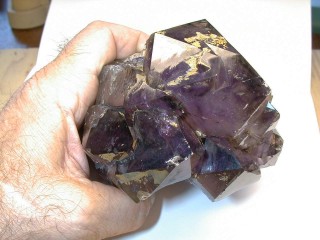 On Father’s Day, Gary went to the mine without me or Jay.
Instead of continuing work in the new pit, he decided to blast a random hole in the far wall of the Eastman quarry. This was one of the things he likes to do that Jay and I always tease
him about. Gary will mine in different area depending on how he feels and the degree of difficulty involving a mine. You could call Gary a “Path of least resistance” miner. It is this
attitude which has led multiple discoveries of his, including several pockets of tourmaline at an abandoned mine in Poland, many pockets of Tourmaline and Purple Apatite at a
mine in Georgetown, Large, gemmy, deep blue aqua crystals at the Russell Brother’s mine in Topsham, the 1996 amethyst pocket in the Eastman Quarry and numerous others. On Father’s Day, Gary went to the mine without me or Jay.
Instead of continuing work in the new pit, he decided to blast a random hole in the far wall of the Eastman quarry. This was one of the things he likes to do that Jay and I always tease
him about. Gary will mine in different area depending on how he feels and the degree of difficulty involving a mine. You could call Gary a “Path of least resistance” miner. It is this
attitude which has led multiple discoveries of his, including several pockets of tourmaline at an abandoned mine in Poland, many pockets of Tourmaline and Purple Apatite at a
mine in Georgetown, Large, gemmy, deep blue aqua crystals at the Russell Brother’s mine in Topsham, the 1996 amethyst pocket in the Eastman Quarry and numerous others. |
|
|
Gary had told me of his plan earlier in the week and so when he showed up at my door at 9:30 pm that day, I jokingly asked him “So, did you find the Mother lode? He Replied, “As a matter of fact I
did.” and proceeded to fill my basement with buckets of amethyst he had uncovered earlier that day. Gary had started to drill his first hole and at about the 5 foot level, the drill bit had fallen into the pocket.
Proceeding cautiously, he drilled some shallower holes and loaded them sparingly. A small blast and some minor jackhammering revealed the entrance to the second largest Amethyst pocket we had ever uncovered at the
Eastman Complex. We went back the next day and mined amethyst well into the night. The pocket was interesting for a number of reasons. For one thing, the specimens were either wonderful, gemmy and undamaged, or
total junk. there was quite a bit of gem rough, although certainly nothing like the 4th of July pocket. Most of the crystals had smokey-tinged corners where the faces met. The kaolin was snow white and very sticky
and contained hundreds of small, pencil diameter, iron-stained quartz crystals. Occasionally, we would find an amethyst scepter crystal floating free in the kaolin. One such crystal that Jay found (and thus claimed)
was baseball in size and absolutely undamaged except that the scepter had fallen off. It was clear and filled with a dark, splotch of pure purple. It exhibited classic Deer Hill color banding, one end purple, the
middle white and the other end purple with a hint of smokey. “Beautiful”, I thought, insane with jealousy as I videotaped it. In the end, it took four good solid days to empty the pocket, which is officially known
as “The Millennium pocket” (and informally known as “The Howard Pocket”) We estimate that it contained somewhere around 1500 lbs. of amethyst, much of it low value tumbling rough but a substantial portion is nice
gem stock and high quality specimens. Further exploration of the immediate area revealed another pocket behind it, but this pocket contained virtually no Amethyst at all. Our revised mining plan includes complete
exploration of the remaining section of quarry wall uphill from the Millennium Pocket.
|
|
|
creaserjewelers@aol.com
|
|
|